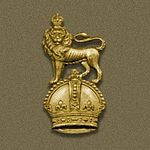- Royal Devon Yeomanry
-
Royal Devon Yeomanry 
Badge of the Royal First Devon YeomanryActive 1794–present day Country  United Kingdom
United KingdomBranch  British Army
British ArmyType Yeomanry Role Challenger 2 replacement Size Squadron Part of Royal Armoured Corps March Widdecombe Fair Anniversaries Monte Cassino Insignia Identification
symbolMaple Leaf The Royal Devon Yeomanry was a Yeomanry regiment of the British Army, first raised in 1794, it participated in the Boer War, World War I and World War II and now forms a squadron of the Royal Wessex Yeomanry.
Contents
History
One of Devon's oldest regiments, the Royal Devon Yeomanry was formed in 1794, and was raised by Sir Stafford Northcot Bt. of Pynes, Exeter on 15 May of that year and was first called out for service on 13 April 1795 in aid of the civil power to put down a riot at Crediton, which had been caused by the high price of bread. At this time the regiment was known as the First Troop of Devon Volunteer Cavalry and was later to become the Royal 1st Devon Yeomanry Cavalry in 1801, commanded by Col the Lord Rolle.
Between the years 1815 and 1850 the regiment was used many times in the internal security role; the last time being on 4 November 1867. The regiment remained in this form until 1920 when it was amalgamated with the Royal North Devon Hussars to become the Royal Devon Yeomanry Artillery.
Boer War
On 13 December 1899, the decision to allow volunteer forces serve in the Second Boer War was made. Due to the string of defeats during Black Week in December, 1899, the British government realized they were going to need more troops than just the regular army, thus issuing a Royal Warrant on 24 December 1899. This warrant officially created the Imperial Yeomanry.
The Royal Warrant asked standing Yeomanry regiments to provide service companies of approximately 115 men each. In addition to this, many British citizens (usually mid-upper class) volunteered to join the new regiment.[1] Although there were strict requirements, many volunteers were accepted with substandard horsemanship/marksmanship, however they had significant time to train while awaiting transport.
The first contingent of recruits contained 550 officers, 10,371 men with 20 battalions and four companies[2], which arrived in South Africa between February and April, 1900.[3] Upon arrival, the regiment was sent throughout the zone of operations.
The Royal Devon Yeomanry provided troops for the 27th Company, 7th Battalion.[4]World War I
During the First World War they saw service in the Dardanelles campaign at the Battle of Gallipoli and in Egypt between 1915 and 1916; it later served in Palestine until May 1918 and in France from 7 May to 11 November 1918. As a result of the reorganisation of the Yeomanry in 1920 and the formation of the Territorial Army the new regiment was armed with 18-pounder guns.
World War II
At the outbreak of the Second World War the regiment was divided to form the 96 Field Regt and the 142 Field Regt RA; the latter fought in Italy, taking part in most of the major actions of that campaign including the landings in Sicily and Anzio and the battle for Monte Cassino. Throughout the campaign the regiment was armed with self-propelled guns. For its support to the Canadian Division it was awarded the right to wear the Maple Leaf of Canada. The 96 Regt fought in the Far East where it was disbanded in 1943.
Post war
The regiment survived until 1967 when it was amalgamated with the 4th Devon's to become the Devonshire Territorials (Royal Devon Yeomanry/ First Rifle Volunteers) RAC; however this ill-fated regiment was destined to last only two years and throughout that time was kept very short of equipment and training time. This regiment was disbanded in 1969 due to yet another major reorganisation of the Territorial regiments as a result of government policy.
With a change of government policy, in 1971 the Territorials were again reformed, and on 1 April a new regiment was born incorporating three old and distinguished cavalry regiments. "A" and "C" Squadrons were formed from the Royal Gloucester Hussars, "B" Squadron from the Royal Wiltshire Yeomanry, and "D" Squadron from the old Royal Devon Yeomanry. The regiment is called the Royal Wessex Yeomanry.
The Royal Devon Yeomanry Museum is incorporated in the North Devon Museum, The Square Barnstaple.
Honorary Colonels
- 1967–1968: Peter Acland [5]
- 1968–1984: Lewis Clifford, 13th Baron Clifford of Chudleigh [6]
- 1984–1992: Sir John Acland [7]
References
- ^ Boer War Notes, http://www.roll-of-honour.com/Regiments/BoerWarNotes.html, retrieved 2007-06-11
- ^ ([dead link] – Scholar search) Imperial Yeomanry, archived from the original on 2007-05-29, http://web.archive.org/web/20070529010837/http://www.regiments.org/regiments/uk/cav/ImpYeo.htm, retrieved 2007-06-11
- ^ Boer War - Imperial Yeomanry Battalions, http://www.roll-of-honour.com/Regiments/ImperialYeomanryCompaniesBoerBn.html, retrieved 2007-07-03
- ^ "anglo boer war". http://www.angloboerwar.com/forces/army_IY.htm.
- ^ London Gazette: (Supplement) no. 44335. p. 6328. 2 June 1967. Retrieved 14 August 2009.
- ^ London Gazette: (Supplement) no. 44558. p. 3864. 29 March 1968. Retrieved 2 November 2009.
- ^ London Gazette: (Supplement) no. 49619. p. 687. 16 January 1984. Retrieved 2 November 2009.
Categories:- Military units and formations established in 1794
- Yeomanry regiments of the British Army
Wikimedia Foundation. 2010.
